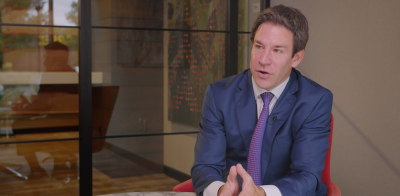If you have read any of my strategy notes the past 16 months, you probably know that I have had a less than constructive view on asset values for a while now and more recently on the U.S. economy. I don’t consider this view to be bearish, just rational. I love green-light-go environments like 2020 and 2021, too! However, if you cling to permabull arguments in cyclical bear markets, or even worse, secular bear markets, the level of asset destruction can be immense and take many, many moons to get back to original asset values (just ask the tech guys). Remember the simple math, if you lose 10%, you only have to make 11% to get back to original asset value; if you lose 20%, you need to make 25%. If you lose 50%, you have to make 100%. If you lose 80%, heaven help you. Downside protection is a crucial part of asset management, particularly for alternatives!
So, let’s now embrace our optimistic, glass is half full mindset and discuss the very bright silver linings in the current stormy market environment (hey, I’ve always been an optimist):
- De minimis 1970s style sustained inflation risk: As I have stated for over the past year, the risk of a repeat of the 1970s is so low that it is almost nonexistent. The Fed was asleep at the wheel in late 2021 and early 2022, and clearly clueless when it came to the risk of inflation surging back in the real economy. However, once they figured it out, the tightening cycle has been epic. Not only have they hiked by 475 bps in record time (with at least one more 25 bps hike to come), but they also embarked on a pace of balance sheet contraction substantially more aggressive than the last quantitative tightening1. Money supply contracted at a record pace (granted they had to reverse a substantial portion of this with recent bank rescues, but are now back to aggressive quantitative tightening1), financial conditions tightened, inflation peaked, and recession here we come. Yes, it’s harder to drive inflation from 4% to 2% and yes, the cost of slaying inflation has been high and will get even higher soon, but much better to drive the economy into a mild recession than to risk a 1970s style stagflationary nightmare. As a reminder, inflation (Consumer Price Index [CPI]) rocketed to 13.5%, the Fed Funds rate skyrocketed to 19.1% and unemployment ultimately hit 10.8%, as Volker finally did what it took to break inflation; the ten-year treasury yield climbed to almost 16%, and the S&P earnings multiple hit a low of seven! If you think there has been financial asset trauma the last 16 months, oh my goodness, can you imagine a repeat of the 1970s? If we all had to plan for a 10% probability of a repeat of the 70s, our jobs would be much harder!
- De minimis risk of a repeat of the global financial crisis: As I have stated before but is certainly worth repeating, the risk of a repeat of the global financial crisis is extremely low (despite the weakest links of the banking system breaking recently).
- Despite deposits fleeing banks to take advantage of higher interest rates in money market funds, courtesy of the Fed’s reverse repo facility and into short dated Treasuries the past nine months, the U.S. banking system still has over $3 trillion in total reserves which dwarfs the $42 billion coming into the global financial crisis.
- The banking system—including systemically important banks or “too big to fail”—still has around 50% more Tier 1 capital2 as a percent of risk-weighted assets than prior to the global financial crisis even after the long duration asset decimation of 2022. And with long dated interest rates coming back down a bit, this number should have gone up a bit in Q1.
- Going into this bear market, real estate loan underwriting standards were still tight and the real estate ecosystem was still cautious because it was way too soon to forget the global financial crisis.
- The Consumer Balance Sheet and residential housing equity value is still off the charts. For instance, consumer total financial obligation ratios (including leases) hit a high of 18% in Q4 of 2007, and in Q4 2022, has only climbed back to 14.4% after record Fed tightening. Total U.S. residential housing equity value hit over $31 trillion recently (although it is now dropping again) compared to $14.4 trillion going into the global financial crisis. Additionally, the average loan-to-value on residential mortgages dropped to a recent record low of 42% in Q2 of last year at the peak of the housing market compared to over 70% in the housing bubble peak of 2006.
- Again, if we had to plan for a 10% probability of a repeat of the global financial crisis, asset allocation would be even more challenging than it already is!
- Risk-free is actually meaningfully above zero and will more than likely stay there for a long time! Unless we have an unforeseen economic or market calamity, the Fed still has one more hike left in them, and then the soonest we could see them cut is the end of this year, but more than likely early 2024. Additionally, we expect the Fed to move slowly and keep rates well above the lows of post-global financial crisis period (0%) for a long time. Who amongst us thought we’d ever see risk-free rates with a five handle as recently as two years ago?
- Alternatives strategies are actually democratized! The industry has come a long way in a short time. Whether it’s democratized private real estate lending, private middle market corporate lending, daily liquid multi-strategy funds, interval funds that can target complex sectors like CLOs, venture lending, private equity/private equity secondaries, or tactical asset allocation strategies, investors have many choices at this stage of the game. The biggest challenge is to actually embrace them!
So, as we watch equities make new lows the next three to nine months and the economy unfortunately commences a recession starting sometime in Q3 of this year to as late as Q1 of next year, don’t forget the bright silver linings of the Galactic Mean Reversion (see, I told you I’m an optimist)!
Investing in alternatives is different than investing in traditional investments such as stocks and bonds. Alternatives tend to be illiquid and highly specialized. In the context of alternative investments, higher returns may be accompanied by increased risk and, like any investment, the possibility of an investment loss. Investments made in alternatives may be less liquid and harder to value than investments made in large, publicly traded corporations. When building a portfolio that includes alternative investments, financial professionals and their investors should first consider an individual’s financial objectives. Investment constraints such as risk tolerance, liquidity needs and investment time horizon should be determined.



